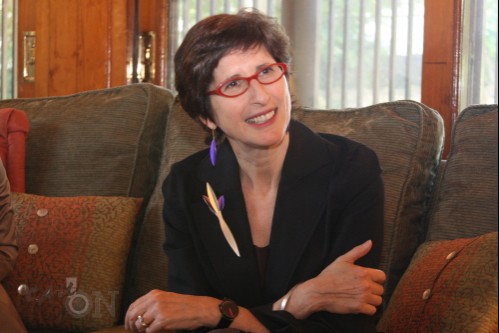
In 1976, the U.S. Government built an ambassador’s residence named ‘Habib House,’ in Korea. It is different from other ambassador’s residence because it is built in a Korean traditional style, ‘Han-ok.’ Many people do not know about this. The Chung-Ang Herald (CAH) reported visited the U.S. ambassador’s residence. The CAH reporter also met the wife of U.S. ambassador, Lisa Vershbow, and talked to her about life in Korean. It was a beautiful house, which looks like a Korean illustrious official’s house. There was the huge ‘Han-ok’ and the landscape was picturesque.
CAH: Unlike other ambassador residences in Korea, your home was built in the traditional Korean style “Han ok” despite the opposition image of U.S. How do you feel about this place?
Lisa: I love this house. I think it is one of the most beautiful houses I have seen. In fact, it is difficult to say anything bad about it. Actually, it is the general practice to build a traditional American style residence for ambassadors in foreign countries. So, this is a new experience.
There was a Korean style house here originally, but it was in poor condition, so it was practically rebuilt. In the mid 70s, the U.S Ambassador Phillp C. Habib recommended building this house. Primarily his reasoning was that this site is partially part of the ‘Deok-su palace’ site. If we had made an American style, we could not show respect for the splendor of ‘Deok-su Palace’. So, he persuaded the United States Government to build a ‘Han-ok’ (a traditional Korean-style house).
This house feels comfortable to me with its timber materials and high ceiling. Many of our Korean visitors are surprised the house is a ‘Han-ok’. And they always respond that ‘this place is a familiar place’ for them. Also, this house showed them how Korean style and American style’s can live in harmony. The exterior of house is a traditional Korean style and the interior of the house has an American style, because of the furniture and decorations. It is a striking place and idea.
CAH: In February, you visited ‘Daegu Wonhwa Girls’ high school’. And you talked about Korea, U.S culture and educational exchanges. What should be done to promote cultural and educational exchanges between our two countries?
Lisa: I think we have to encourage more American students to come to Korea. I know that we have a large numbers of Korean students in America already. And cultural exchange for education is probably one of the most important things we can do. Because it builds on the future and I think it helps promote understanding between two countries I think it’s our job to let them know that they need to come here. I just thought it was our job to let American students know about Korea, but the more English language programs become available here, it is not uncommon for Americans to study Korean language the way it is for Koreans to study English. I think the more schools, which I know many already do, offer courses in English; the more American students will come here to study. There are Korean language exchanges becoming more wildly available on the internet. With theses programs, we can promoted and attract more students to come.
CAH: You have been involved in many programs here in Korea with passion. Have you experienced any difficulties or do you have any stories that you could share with us?
Lisa: I’ll tell you the only difficulty is language. Fortunately I have a lot of help but I’m more surprised how many students understand English. I love all the programs I do. So the biggest surprises to me are the similarities more than the differences considering what a different culture Korea is from my own. When I go to an art school at the university, I admire their hard work and their devotion to it. And, their interest and their creativity are very similar to what I see in the United States. So it is really a lot of fun for me to lecture. We give the same lecture that I would do in American art school when I visit there.
One of the most fun places I visited was ‘Busan Design high school’. Those students really surprised me, because they were doing such interesting work at such a young age. And I offered a workshop for them on making jewelry with what I called ‘Found Objects’, which are materials we can find in everyday life. We combined Wheat Thins (a kind of cracker) with telephone wire and plastic buttons. They were very excited and immediately wanted to make things. So I think we surprised each other. When I give lectures about what influences me and very often it’s the place where I am living.
CAH: You have held several exhibitions since you came to Korea such as using ‘Han-ji’, the Korean paper, to show the American culture. What do you think it is so attractive about ‘Han-ji’? Do you have any plans to promote Korean culture through your exhibitions once you return to the U.S?
Lisa: I love all the materials I've encountered here. And it's been a surprise to me, because normally I expected to find things for making jewelry, metals or stones. But those were already familiar to me. Jade or metals just don't change. But natural materials like ‘Han-ji’, they are a very thick paper and have such body to it-so much substance for textiles. They are very interesting, so I think creating things will be natural for our displays. I hope to show the Korean culture, because I think the ‘Han-ji” is interesting. So I want to share these materials with many American artists, who would also be interested in it.

